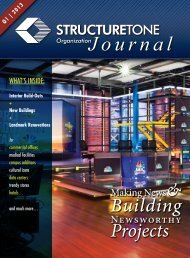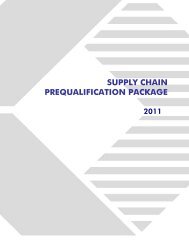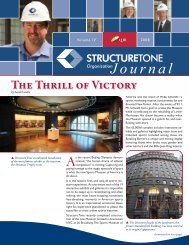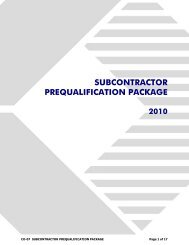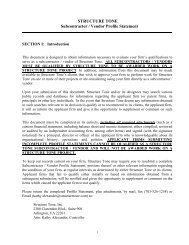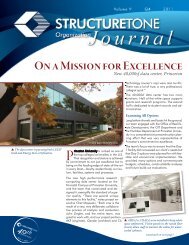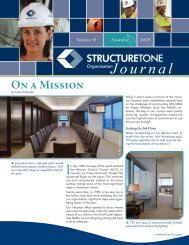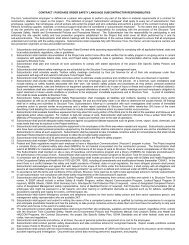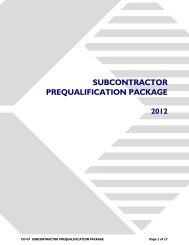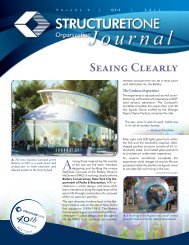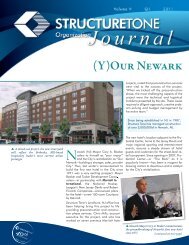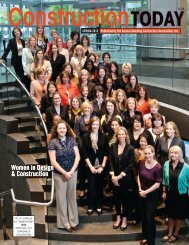BEinG NEiGh oRly - Structure Tone Inc.
BEinG NEiGh oRly - Structure Tone Inc.
BEinG NEiGh oRly - Structure Tone Inc.
Create successful ePaper yourself
Turn your PDF publications into a flip-book with our unique Google optimized e-Paper software.
Being Neighborly<br />
by Katie Wells<br />
To blend with the existing community,<br />
the Buddhist Cultural Center’s building<br />
skin consists of a combination of stone,<br />
stucco, wood and other finishes<br />
Winter<br />
© Dan Cunningham<br />
When looking for a new place of residence,<br />
it’s not often that you find<br />
the perfect location along one of<br />
the most popular Avenues in the United States.<br />
But, Massachusetts Avenue, or Embassy Row as<br />
it’s known in the District of Columbia, is now<br />
home to the second oldest Buddhist community<br />
in theWashington, DC metropolitan area.<br />
Since 1968, the Soka Gakkai International<br />
(SGI)-USA Cultural Center was located on<br />
the edge of the District of Columbia in Mt.<br />
Ranier, MD. With membership continuing to<br />
grow, the Buddhist community was in need of<br />
a new, more accommodating space. SGI called<br />
on the construction services of <strong>Structure</strong><br />
<strong>Tone</strong> and Hellmuth Obata + Kassabaum Architects<br />
(HOK) to construct their new place<br />
of worship.<br />
2009<br />
“Inadditiontomeshingwiththesurrounding<br />
community, concerns for the building were<br />
that it encompass the natural and peaceful<br />
elementsthatareessentialforBuddhistworship<br />
areas. We accomplished both goals.”—<br />
Michael Zajkowski, AIA, lead architect, HOK<br />
The 20,000sf building was constructed on a vacant<br />
lot purchased from the adjacent Embassy<br />
of Cape Verde, the Embassy building being a<br />
landmark listed in the District of Columbia Inventory<br />
of Historic Sites.With this in mind, the<br />
team focused on existing elements in the<br />
neighborhood—stucco, stone, copper and<br />
wood—so that the new building fit seamlessly<br />
with its surroundings. SGI, HOK and <strong>Structure</strong><br />
<strong>Tone</strong> met with the neighborhood committee<br />
Rendering courtesy of HOK<br />
Model depicting the neighborhood with the<br />
Embassy of Iraq (l), Buddhist Cultural Center<br />
(c)andtheEmbassyofCapeVerde(r)<br />
(continued on next page)
2<br />
NeighborsandSGImembersalikearedelightedwiththenew<br />
building<br />
on several occasions during design and<br />
throughout construction. Being the ‘new kid<br />
on the block’ in such a prestigious community,<br />
the entire team wanted to ensure that<br />
we established good relationships with the<br />
neighbors.<br />
<strong>Structure</strong> <strong>Tone</strong> worked with the community<br />
throughout each task to make sure it was<br />
aware of construction activity going on in and<br />
around the site. Also, when there were unavoidable<br />
circumstances,we worked with the<br />
team to give back in unique ways.For instance,<br />
excavation for the foundation and underground<br />
parking garage created unavoidable<br />
dust and dirt.The project team supplied each<br />
household in the area with a ticket for a free<br />
car wash, a gesture of sensitivity and understanding<br />
that was very welcome.<br />
Another challenge throughout the project<br />
was working within a small lay-down area<br />
for construction and equipment.The building<br />
footprint encompasses the entire property.<br />
In addition, this new zero-lot line facility is<br />
In Good Company<br />
Over 57 nations are represented along<br />
“Embassy Row”—the portion of Massachusetts<br />
Avenue where the new Cultural<br />
Center is located. <br />
© Dan Cunningham<br />
located between two<br />
sovereign embassies<br />
and the Vice President’s<br />
residence is<br />
nearby. Thus, there<br />
were restrictions on<br />
Massachusetts Avenue<br />
to ensure the<br />
safety and protection<br />
of these high profile<br />
sites, complicating the<br />
staging and movement<br />
of materials.<br />
<strong>Structure</strong> <strong>Tone</strong>’s access<br />
to the construction<br />
site was limited<br />
to a rear alley for all deliveries. Further, material<br />
entry had to be coordinated in advance<br />
with the Secret Service.<br />
In addition to its location and special requirements<br />
as a place of worship, the Cultural<br />
Center has special design features that<br />
make the project unique. A storm water<br />
management system,or green roof,which includes<br />
a 2,500sf roof-top vegetative garden,<br />
was added to the building. The green roof<br />
consists of drainage-layer water retention<br />
panels, filter fabric, organic mineral soil and<br />
vegetative roof covering.The green roof reduces<br />
summer temperatures in the building,<br />
in turn reducing cooling costs.<br />
The exterior landscaping is another special<br />
project feature. It is in harmony with both<br />
the Buddhist faith and the neighboring diplomatic<br />
embassies, churches and large homes.<br />
The outdoor plaza in the front of the building<br />
displays trees and perennials native to<br />
Japan—Kwanzan Cherry and Japanese<br />
Maples—creating a connection to the origins<br />
of the Buddhist faith.<br />
The entire building was designed to be built<br />
with natural materials.The exterior mirrors<br />
the surrounding neighborhood and the interior<br />
is primarily earth tones and eco-friendly<br />
materials,reflecting,and respecting,nature.The<br />
lay-down area was also planted as much as<br />
possible to reduce hard surfaces and runoff.<br />
W I N T E R | 2 0 0 9<br />
“<strong>Structure</strong><strong>Tone</strong>wasveryresponsivetothe<br />
demanding nature of this project,” said<br />
WilliamAiken,associatedirectorofSGI.“We<br />
(SGI committee) were very happy with<br />
how the team dealt with all aspects of the<br />
project, especially Mike Marchesani, who<br />
really kept a close eye on every detail to ensurethateveryone,includingallourneighbors,<br />
were happy.”<br />
The 200-seat main sanctuary, the heart of<br />
the building, features a combination of walnut<br />
and maple wood panels.These rich elements<br />
are surrounded by fabric wall<br />
coverings, carpet and custom lighting augmented<br />
by floor-to-ceiling windows that create<br />
a bright ambiance throughout the day.<br />
Construction of the Buddhist Cultural Center<br />
has received rave reviews from members<br />
of the congregation, neighbors and the District<br />
of Columbia. SGI hosted a few open<br />
houses before the grand opening, one of<br />
The large sanctuary features high-end<br />
finishes such as hand-gilded metal on the<br />
ceiling<br />
© Dan Cunningham
Special project considerations included<br />
coordinating construction with the Secret<br />
Service to ensure the security of the Vice<br />
President’s residence and several embassies<br />
© Dan Cunninghampher<br />
which was exclusively for their new neighbors<br />
who were fascinated by the end product.<br />
And, SGI members who came from all<br />
over the world for the opening were nothing<br />
short of stunned by their new cultural<br />
center, centrally located in the heart of the<br />
Nation’s capital. <br />
“This building, our center, went beyond<br />
the expectations that we had when we<br />
started the project,” commented Aiken.<br />
“Membersfromtheearliestyearsofourestablishmenthavecometoseethecenterand<br />
sayit’snothingshortofa‘dreamcometrue’<br />
for them. To have a faith center that is so<br />
beautiful, that encompasses the beliefs of<br />
ourreligionandisalsoawelcomeneighbor,<br />
it’s just really something to be proud of.”<br />
W I N T E R | 2 0 0 9<br />
© Dan Cunningham<br />
Executive Focus<br />
by Jim Donaghy<br />
The end of a year and the beginning<br />
of a new one is an interesting time<br />
of reflection and anticipation. In particular,<br />
as 2008 closed and 2009 began, I<br />
found myself thinking a great deal about<br />
our history and how that translates to<br />
our future.<br />
During those periods of introspection, one<br />
thought came to me time and again—what<br />
distinguishes <strong>Structure</strong> <strong>Tone</strong> in our industry<br />
is our professionals, those who focus<br />
every day on servicing our clients. Service<br />
is not merely a phrase at <strong>Structure</strong><strong>Tone</strong>, it<br />
is a way of life.<br />
Since our founding as a two-person firm<br />
almost 39 years ago, our cornerstone has<br />
been our clients’ needs.Without client relationships<br />
we would not be in business<br />
today. Our founders emphasized ‘focus on<br />
the client and the rest will come’—meaning<br />
growth, profitability, industry prominence<br />
and other measures of success.<br />
They could not have been more right as<br />
today we enjoy a position as a clear market<br />
leader.<br />
While client service has been the lifeblood<br />
of our growth, our people have been the<br />
bedrock of that achievement. Even in a<br />
business as competitive as construction<br />
management, a sustainable, successful organization<br />
is far more than the sum of its<br />
services and project track record. Successful<br />
projects and delighted clients are driven<br />
by our staff. People resolve challenges, people<br />
innovate, people go the extra mile—<br />
nothing can take the place of talented,<br />
dedicated human beings focused on helping<br />
you meet your goals.<br />
Because of our people, in today’s uncertain<br />
economic times, we are well positioned to<br />
weather the storm while consistently delivering<br />
to our clients. From principals who<br />
have been with our firm for over three<br />
decades to superintendents with similar<br />
levels of tenure, the passion and tradition<br />
of client service is instilled at all levels in<br />
our organization. This encompasses all<br />
facets of our business as we recognize that<br />
total client service extends beyond construction<br />
activity at the site. We are investing<br />
in our future by investing in the<br />
professional development and career advancement<br />
of quality professionals who<br />
embrace and embody our core values.<br />
Also, as a privately-held organization we<br />
have the flexibility to move in tandem with<br />
our clients’ needs and the market drivers<br />
affecting them. Our principals are handson,<br />
often seen at project walk-thrus and<br />
team meetings.This keeps us in touch with<br />
your day-to-day needs and expectations<br />
and allows us to be fluid and expedient<br />
making decisions in your best interests.<br />
Similarly,our ownership enables us to focus<br />
on controlled growth not artificial revenue<br />
goals. Over the past four decades each step<br />
forward has been taken with great care and<br />
deliberation—always predicated on the<br />
questions, “how does this benefit our<br />
clients” and “is it a sustainable business<br />
model?” Whether geographic expansion,<br />
market sector diversification, or service/<br />
project delivery innovation—client relationships<br />
and our ability to better serve<br />
them have been our business drivers.<br />
As we look to 2009 and beyond, we will<br />
not be shaken from this core value. Our<br />
firm was founded in the early 1970s on the<br />
cusp of extremely difficult<br />
economic times. Despite<br />
that, and due in large part<br />
to our client-first, last<br />
and always mandate, we<br />
were able to grow and<br />
prosper. Our unique culture<br />
and stable ownership<br />
position us for more of<br />
the same in the coming<br />
years. I look forward<br />
to the future<br />
with great enthusiasm.<br />
<br />
3
4<br />
ChartingaNewCourse<br />
by Giovana Moreano<br />
StandardChartered’selevatorlobbyinTwoGatewayCenter<br />
features glass wall panels depicting sporting events<br />
Corporate Photographics:<br />
Bob Zucker, Photographer<br />
Just as C&K Properties committed to accommodating its new tenant,<br />
Standard Chartered Bank, <strong>Structure</strong> <strong>Tone</strong> committed to delivering<br />
a top quality office for C&K Properties to present to Standard<br />
Chartered. A festive ribbon-cutting ceremony officially revealed<br />
a new space on the 13th floor of Two Gateway Center in Newark,<br />
NJ and heralded the beginning of a new relationship in New Jersey<br />
between C&K Properties, Standard Chartered and <strong>Structure</strong> <strong>Tone</strong>.<br />
After considering various locations throughout New Jersey, Standard<br />
Chartered Bank chose Two Gateway Center in Newark to<br />
relocate employees from One Madison Avenue in Manhattan.The<br />
new 45,000sf office space provides Standard Chartered staff with<br />
open working space, a reception lobby, lounge areas, pantries and<br />
multiple conference rooms equipped with A/V systems and video<br />
conferencing capabilities.<br />
Unique details throughout the space give this new home a sparkle<br />
that one cannot miss. The elevator lobby is one of the main highlights.<br />
It offers visitors and employees an engaging first<br />
impression featuring glass wall panels with colorful (interchangeable)<br />
graphics of various sporting events. Pantries feature Bottacino<br />
marble countertops and glass tiles on backsplashes, restrooms<br />
“Thankstothetremendouseffortsofthe<strong>Structure</strong><strong>Tone</strong>teamand<br />
itssubcontractorsincompletingthespaceinaveryaggressivetime<br />
frame.Itiswithgreatgratitudeandappreciationthatwecongratulate<br />
the entire team for bringing to fruition such a beautiful and<br />
functional space.”—Patty Fuster, head of information and administrative<br />
services—Americas, Standard Chartered Bank<br />
Corporate Photographics: Bob Zucker, Photographer<br />
have imported porcelain tiling, conference rooms are divided by<br />
modern-fold sky-wall partitions, and decorative glazing surrounds<br />
the reception area.<br />
As it is with all our projects, delivering a successful project on time<br />
and within budget while exceeding our clients’ expectations is one<br />
of <strong>Structure</strong> <strong>Tone</strong>’s top priorities. But, as is often the case, getting<br />
there without facing any challenges is rare.<br />
Working in an occupied building always creates logistical challenges—add<br />
in a very aggressive 14-week schedule and this increases<br />
exponentially. With law firms both above and below the<br />
construction floor, scheduling all noise-related work around depositions,<br />
meetings and court reporter activities made our team’s<br />
task difficult. By working closely with the property manager and all<br />
our subcontractors, we devised a plan to accommodate surrounding<br />
tenants’ business requirements while still maintaining our targeted<br />
schedule.This plan entailed adding shift and weekend work<br />
to avoid noise impacts, as well as to provide our subcontractors<br />
with additional time to complete tasks.<br />
A key part of the office renovation was installation of a new UPS,<br />
generator, dry-coolers, AHUs and CRAC units.The busy and congested<br />
streets of downtown Newark were a challenge for our team<br />
when it came time for roof installation. In order to conduct a successful<br />
installation while operating a 50ft crane within narrow<br />
streets, our team coordinated closely with the city of Newark.With<br />
the help of targeted street closures and police escorts, we were<br />
able to complete the installation efficiently and without incident.<br />
Safety planning and preparation for work in the occupied space<br />
was a critical component contributing to the project’s success. One<br />
of the most important phases of safety planning encompassed the<br />
construction of an electrical riser shaft running from the basement<br />
to the 19th floor penthouse. For this delicate phase of work, our<br />
The pantry offers a quiet respite for staff, with a glass backsplash,<br />
marble countertops and soft-toned walls<br />
W I N T E R | 2 0 0 9<br />
Corporate Photographics:<br />
Bob Zucker, Photographer
Open plan working spaces contribute to the collaborative<br />
environmentofthenewGatewayCenterspace<br />
A Clear Winner<br />
by Jason Vesuvio<br />
The Urban Glass House, located at 330<br />
Spring Street in Lower Manhattan, recently<br />
received its third industry award.<br />
Buildings magazine bestowed a Citation of<br />
Excellence on the project in the publication’s<br />
2008 New Construction Awards program.<br />
Pavarini McGovern, a member of the <strong>Structure</strong><strong>Tone</strong><br />
organization,served on the team as<br />
construction manager.<br />
Buildings Magazine’s annual Project Innovations<br />
program reviews NorthAmerica’s most<br />
prestigious projects in four project award<br />
competitions: Buildings Interiors ® Design,<br />
Greener Facilities (a new recognition this<br />
year),Modernization and New Construction.<br />
Criteria included aesthetics, function, performance<br />
and sustainability.<br />
The 12-story, glass-walled condominium<br />
building, designed by Philip Johnson + Alan<br />
Ritchie Architects, invokes the same standards<br />
of excellence and rigorous attention<br />
to detail as the late Mr. Johnson's world-fa-<br />
Corporate Photographics:<br />
Bob Zucker, Photographer<br />
safety director created a job hazard analysis, reviewed it with the<br />
entire team and implemented strict, specific protection measures<br />
for this work.<br />
The new Urban Glass House, 330 Spring<br />
Street, New York City<br />
mous Glass House in New Canaan, CT.To<br />
accomplish this, a major issue confronting<br />
the team was constructing the building next<br />
to the historic landmark Ear Inn—a two-<br />
Robert S. Varcoe Photography<br />
“Iwantedtothankeveryoneat<strong>Structure</strong><strong>Tone</strong>fortheextraordinary<br />
job they have done in completing this incredibly complex project in<br />
record time. I know that Meir Cohen and Ben Korman (C&K<br />
Principals) join me in thanking you and your entire team for your<br />
efforts.”—Kevin Collins, chief financial officer, C&K Properties<br />
Care and concern for our employees and subcontractors, the comfort<br />
of other building tenants and, ultimately, the new residents of<br />
the 13th floor, manifested itself in every aspect of our work.This<br />
was a reflection not only of <strong>Structure</strong> <strong>Tone</strong>’s mandates, but also<br />
our recognition that, while in the building, we are an extension of<br />
our client.This was not only the cornerstone of project success but<br />
the foundation upon which to build our relationship with C&K<br />
Properties and Standard Chartered Bank. <br />
W I N T E R | 2 0 0 9<br />
Robert S. Varcoe Photography<br />
story, 200-year-old timber framed structure.<br />
During the excavation and foundation phase,<br />
the team took great care when performing<br />
the required underpinning of the Inn. <br />
“We are honored to be part of the team for<br />
a project that has received so much recognition<br />
in the local New York, and now national,constructionmarkets,”saidBillFrederick,<br />
executive vice president for Pavarini<br />
McGovern and the company’s principal for<br />
the project. “The successful construction of<br />
theprojectwasdueinlargeparttotheteam<br />
we assigned to it,” said Frederick, “particularlygiventhelogisticalchallengeswefacedduringthefoundationphaseandthequality<br />
of fit and finish demanded by the highend<br />
interiors.”<br />
5
6<br />
Loosening Up<br />
by Laura Schneider<br />
One of Edelman’s most unique features—the café bar—is a place<br />
where employees and guests meet and relax with a snack or drink<br />
After deciding to combine four existing<br />
offices into one European headquarters,<br />
London’s largest independent<br />
public relations agency,Edelman,was eager to<br />
explore the possibilities an open design plan<br />
offered. Guided by Gensler, the project architect,<br />
and its own strong vision,Edelman focused<br />
on effectively organising all employees<br />
under one roof and creating a youthful and<br />
relaxed vibe in the office environment.<strong>Structure</strong><br />
<strong>Tone</strong> joined the collaborative effort,<br />
bringing construction expertise to help Edelman<br />
achieve the radical change desired.<br />
For Edelman, time had called for change. For<br />
<strong>Structure</strong> <strong>Tone</strong>, time was of the essence.<br />
With only an idea in mind, but a firm moveout<br />
date in hand, time management and efficiency<br />
were major priorities for this project.<br />
<strong>Structure</strong> <strong>Tone</strong> met the (17-week) schedule<br />
challenge head-on.<br />
By actively engaging with the supply chain<br />
early on and determining the best methods of<br />
procurement,we were able to facilitate accelerated<br />
advancement of the project from concept<br />
to detailed design and begin working with<br />
detailed working drawings at the earliest opportunity.<br />
Thus, we were able to deliver the<br />
early handover of the server room in a mere<br />
ten weeks enabling Edelman to complete its<br />
IT technical fit-out and resolve any communication<br />
issues prior to move-in.<br />
© Charles Birchmore<br />
In another schedule<br />
saving measure, our<br />
team evaluated the existing<br />
lighting control<br />
system and was able<br />
to adapt it to<br />
suit the new lighting<br />
scheme requirements.<br />
By avoiding stripping<br />
out the existing system,<br />
we were not only<br />
able to save schedule<br />
but also budget.<br />
The new 32,000sf<br />
Edelman office features<br />
an open layout<br />
that offers maximum<br />
client-facing opportunities and breaks down<br />
barriers between staff. With ten conference<br />
rooms of various size equipped with full A/V<br />
technology, glass-fronted executive offices,<br />
several modern breakout spaces and inviting<br />
quiet areas, the environment truly facilitates<br />
collaboration and interaction.<br />
“This is unndoubtedly an office, and client,<br />
with personality,” noted project executive<br />
Alan Ford. “While we certainly had challenges,<br />
it was also quite a bit of fun bringing<br />
to reality the unique vision of Edleman and<br />
Gensler.”The space contains cozy oversized<br />
furniture, vibrant colors throughout and<br />
comedy-themed conference rooms.<br />
However, the most intriguing additions—<br />
those that push the boundaries of the 21st<br />
Century workplace—are the café bar and the<br />
executive bar. Upon entering the office, one<br />
immediately notices the peculiar absence of a<br />
reception desk in the lobby. Instead, visitors<br />
are greeted by the next passing employee and<br />
ushered to a café bar where they can catch<br />
their breath in tall chairs and munch away on<br />
snacks while they wait.<br />
Three smaller executive meeting rooms are<br />
combinable and can be opened to accommodate<br />
functions of up to 100 people. At<br />
the top of this space is the executive bar<br />
and a small food prep area. But, even when<br />
there are no formal functions, the bar still<br />
W I N T E R | 2 0 0 9<br />
© Charles Birchmore<br />
One of several glass-enclosed, comedythemed<br />
conference rooms<br />
© Charles Birchmore<br />
offers bottles of beer or cool glasses of<br />
Chardonnay for staff to enjoy while relaxing<br />
and socialising at the end of a productive<br />
day at work.<br />
Edleman’s office revolutionises the work<br />
space and shatters preconceived notions of<br />
the “stuffy” work environment. Just as Edelman<br />
rose to that (self-imposed) challenge,<br />
<strong>Structure</strong><strong>Tone</strong> brought its A-game to ensure<br />
that our construction delivery was commensurate<br />
with their goals and vision. <br />
© Charles Birchmore<br />
With its new office space, Edelman sought<br />
to redefine the work envirnoment
TakeaBow<br />
by Aliona Ortega<br />
St.Thomas Aquinas High School, a fouryear<br />
college-preparatory school in<br />
Fort Lauderdale, FL had a vision for its<br />
new performing arts center—the facility<br />
had to be capable of supporting a wide<br />
range of programs, whether educational, social<br />
or cultural. Pavarini undertook the challenge<br />
and orchestrated the successful construction<br />
ofThe Bienes Center for the Arts.<br />
Only five days after Pavarini delivered the<br />
project’s temporary certificate of occupancy,<br />
Archbishop of Miami, John C. Favalora,<br />
blessedThe Bienes Center for the Arts<br />
at a dedication ceremony. Present were the<br />
‘cast and crew’ that made the whole production<br />
possible, including the founding<br />
donors Mr. and Mrs. Michael Bienes, Mr. and<br />
Mrs. Damon DeSantis and Mr. and Mrs.<br />
Manny Velar; Monsignor Vincent T. Kelly, supervising<br />
principal of the school; and representatives<br />
from Pavarini and Ziedler<br />
Partnership, the architect. Students and faculty<br />
also attended to celebrate the new addition<br />
to campus.<br />
Featuring a dramatic 45ft-high glass-walled<br />
lobby with a grand staircase to the upper<br />
tiers, this new multi-functional facility accommodates<br />
a variety of events, including<br />
theater performances and banquets. Designed<br />
to deliver enhanced sightlines and<br />
Pavarini constructed the new theater/<br />
auditorium, including a rounded, glass<br />
curtain wall lobby<br />
acoustics, performers can step right into the<br />
spotlight and delight audiences. Retractable<br />
seating also easily converts the theater into<br />
a banquet hall with a maximum seating capacity<br />
of 334 for banquets and other community<br />
functions.<br />
The ensemble of Pavarini and Ziedler Partnership<br />
and its consultant team played to<br />
the tune of meeting the vision and accommodating<br />
the needs of the client. We advised<br />
on selection of materials for the<br />
seating and retractable bleacher system and<br />
assisted with pricing and selection of lighting<br />
systems. Also, collaborative efforts on<br />
the design of the stage drapes allowed for<br />
the option of a black box theater. Conver-<br />
The glass-walled lobby and grand staircase are among the most striking features of the new Arts Center<br />
W I N T E R | 2 0 0 9<br />
sion elements were installed to require minimal<br />
transition effort without compromising<br />
the Center’s elegance.<br />
A project of this magnitude requires many<br />
trades, all managed by Pavarini. In addition, a<br />
number of specialty materials and products<br />
were required from throughout the US.<br />
Much like the conductor of a band, Pavarini<br />
gave the ‘cue’ to each trade at the appropriate<br />
time and meticulously controlled the<br />
tempo of construction. In the end, praise<br />
and appreciation from the client was our<br />
memorable curtain call. <br />
Monsignor Vincent Kelly commented, “The<br />
St.ThomasAquinasHighSchoolwasfortunate<br />
to have Pavarini Construction<br />
buildournewperformingartscenter.The<br />
quality of workmanship, and Pavarini’s<br />
ability to work within our budget and<br />
schedule constraints, combined to make<br />
this addition to our campus a resounding<br />
success. The Bienes Center for the Arts is<br />
not only a teaching facility, it is also a gift<br />
to the community.”<br />
7
8<br />
Live and Learn<br />
by Valerie Hamilton<br />
Should I live on or off campus?<br />
This is a question faced by freshmen,<br />
and even many upperclassmen,<br />
each year. Living on campus adds<br />
a unique dimension to college life, an<br />
experience that Manhattan College<br />
values highly for its students.With the<br />
recent addition of the College’s newest<br />
student residence, East Hill Tower II,<br />
Manhattan College is demonstrating<br />
its commitment to provide students<br />
the best all-around experience they<br />
can receive. East Hill Tower II, and<br />
other on-going renovations to the<br />
campus, are changing the face of undergraduate<br />
life at Manhattan College.<br />
“With an increasing demand by students for<br />
a residential college experience, Manhattan<br />
has changed with the times,” says Robert<br />
Mahan, vice president for facilities at Manhattan<br />
College, noting that “just 25 years ago<br />
Manhattan was 25 percent residential and<br />
with the new East Hill Tower II completed<br />
we are now 75 percent residential. Quality<br />
residence halls, new recreation facilities and<br />
the wonderful 24/7 O’Malley Library learning<br />
center provide a well rounded experience<br />
for our students outside of the classroom.”<br />
Getting Settled<br />
With space to accommodate over 500 students,<br />
the state-of-the-art new residence<br />
ThenewEastHillTowerIIoffersManhattanCollege<br />
students a modern student-life-focussed living environment<br />
Corporate Photographics:<br />
Bob Zucker, Photographer<br />
Every floor includes lounges for socializing<br />
or group study<br />
hall provides a place for study, socializing and<br />
growth.The residence hall offers two bedroom<br />
suite-style rooms, gathering/study<br />
lounges and a laundry facility on every floor.<br />
It is located near Horan Hall, also a student<br />
residence, facilitating the lifestyle of today’s<br />
active college student.<br />
Like Horan Hall (constructed by Pavarini in<br />
1990), the footprint of Tower II was one of<br />
the most challenging aspects of the project.It<br />
was constructed in a logistically-challenging<br />
sloped hillside on an active,occupied campus.<br />
Detailed preconstruction planning and coordination<br />
was critical for excavation of existing<br />
fill behind a massive stone retaining wall, and<br />
rock. Also, an extensive earth retaining system<br />
was provided as there was a 60ft-deep<br />
excavation that occurred within 20ft of the<br />
corner of Draddy Gym. The expertise and<br />
precision of our staff made the removal of<br />
8,000 yds of rock and 27,000 yds of earth an<br />
uneventful effort on the campus.<br />
Safety and campus access for students and<br />
faculty were paramount, among other issues,<br />
as we prepared detailed logistics plans.We installed<br />
a protective sidewalk bridge and<br />
placed concrete jersey barriers and temporary<br />
fencing to protect individuals traversing<br />
the campus adjacent to the site. In addition,<br />
we held weekly site safety meetings to review<br />
upcoming activities, and any related special<br />
safety requirements,and to address concerns<br />
or special needs of the College.<br />
Corporate Photographics: Bob Zucker, Photographer<br />
Corporate Photographics:<br />
Bob Zucker, Photographer<br />
Further, we were required to share a<br />
narrow driveway that provides access<br />
to a very busy campus loading dock.<br />
This entailed significant coordination<br />
of deliveries with the College’s facility<br />
department.<br />
The new East Hill Tower II is a<br />
134,000sf,10-story concrete structure<br />
with an exterior skin comprised of 421<br />
pre-engineered, pre-fabricated light<br />
gage framing brick veneer wall panels,<br />
inclusive of the window assemblies.The<br />
panels were hoisted, dropped into<br />
place systematically and welded to inserts<br />
in the structural slab to create the<br />
building shell. The pitched roof is<br />
framed-out in steel and metal decking with<br />
insulated board covered with asphalt shingles.<br />
Pavarini also constructed the interior of the<br />
new residence, including student bedroom<br />
suites and bathrooms, lounges and study<br />
areas. Heating and cooling is provided by<br />
thru-wall PTAC units fed from boilers in the<br />
adjacent Horan Hall.<br />
Getting There<br />
W I N T E R | 2 0 0 9<br />
Pavarini was also construction manager for<br />
a new 209,000sf, 550-car, five-story, pre-cast<br />
parking structure. The garage was vital to<br />
opening the new dorm as the parking spaces<br />
were needed to support the students<br />
housed in the new tower.<br />
Just the Facts<br />
Pavarini has also provided upgrades to one<br />
of the dining/cafeteria spaces in Thomas<br />
Hall, including:<br />
Renovation of the Dantes cafeteria<br />
featuring a new seating area behind<br />
a bowed glass window wall<br />
Revision of the servery partition layout<br />
to maximize flow of students through<br />
the food court and to the seating area<br />
Installation of new VCT tile, specialty<br />
lighting and other finishes<br />
Protection of existing kitchen and<br />
food prep areas by creating a negative<br />
air pressure environment during<br />
construction
A Story Unfolds...<br />
byAlyssaSansandFrankRenzler<br />
Alfred Hitchcock was known to plan every camera angle<br />
for every scene in his movies in such detail that he<br />
almost didn’t need to be present for filming—someone<br />
else could do it. The movie industry calls this planning<br />
“storyboarding.” In the construction world, all of this detailed<br />
planning is called preconstruction, and, for a project like the<br />
new Bank of America Tower at One Bryant Park,<br />
storyboarding was essential to the success of the project.<br />
(continued on inset)<br />
16<br />
ISO Certified<br />
bySarahLembo<br />
<strong>Structure</strong><strong>Tone</strong>’s London office recently received ISO:9001:2000<br />
accreditation.This confirms that we operate Quality Management<br />
Systems in accordance with all ISO requirements.<br />
“Thisisanimportantstepforourbusiness,” notesDeanManning,managingdirectorof<strong>Structure</strong><strong>Tone</strong>inLondon.“ISOqualitymanagementstandardsareanimportantcornerstoneaswe<br />
continually improve our processes and product and, ultimately,<br />
customer satisfaction—our paramount goal.”<br />
ISO (International Organization for Standardization) is the world’s<br />
largest developer and publisher of International Standards. ISO is a<br />
non-governmental network of<br />
the national standards institutes<br />
of 157 countries that bridges<br />
public and private sectors.<br />
The ISO 9000 family addresses<br />
quality management.This means<br />
what an organization does to fulfill<br />
its customers’ quality requirements<br />
and applicable regulatory<br />
obligations while aiming to enhance<br />
customer satisfaction and achieve<br />
continual improvement of its<br />
performance in pursuit of<br />
these objectives. <br />
Top Honors<br />
by Lisa Ruano<br />
Texas Construction and NewYork Construction, regional industry publications of McGraw-Hill, have selected our organization’s projects<br />
as the Annual Best Of the respective regions in 2008.<br />
Constructors & Associates<br />
Marriott Rivercenter<br />
Best Hospitality<br />
San Antonio,TX<br />
Marriott Solana<br />
Maquire Partners<br />
HKS<br />
Legorreta & Legorreta<br />
DMJM Rottet<br />
Blum Consulting Engineers, <strong>Inc</strong>.<br />
Huitt-Zolllars<br />
Ingenium, <strong>Inc</strong>.<br />
MESA Design Group<br />
Constructors & Associates<br />
Marriott Solana<br />
Award of Excellence<br />
Hospitality<br />
Westlake,TX<br />
Host Hotels & Resorts<br />
Marriott Rivercenter<br />
RTKL<br />
Broaddus & Associates<br />
Blum Consulting Engineers, <strong>Inc</strong>.<br />
Pavarini McGovern<br />
40 Mercer Street<br />
Best Residential<br />
New York, NY<br />
Hines<br />
Hotels AB<br />
EMJ Management<br />
Ateliers Jean Nouvel<br />
SLCE Architects<br />
W I N T E R | 2 0 0 9<br />
<strong>Structure</strong> <strong>Tone</strong><br />
Bank of America<br />
Best Green Building<br />
One Bryant Park, NYC<br />
Bank of America<br />
The Durst Organization<br />
Gensler<br />
Jaros Baum & Bolles<br />
Jones Lang LaSalle<br />
The garage’s main entrance is located directly on Broadway and an<br />
elevated, pre-cast ramp connects the garage to Manhattan College<br />
Parkway to the west.This required comprehensive maintenance and<br />
protection of traffic plans as part of our preconstruction planning.<br />
Like East Hill Tower II, foundation work for the parking structure<br />
was complex.The foundation is a combination of driven and drilled<br />
piles bearing on bedrock at depths between 15ft and 45ft and in<br />
close proximity to New York City Transit (NYCT) structures.This<br />
proximity required very specific provisions to satisfy the requirements<br />
of NYCT. These included vibration monitoring, working<br />
under the supervision of NYCT inspectors and precise coordination<br />
with NYCT train schedules. Also, height restrictions beneath<br />
the transit structures limited access to the site.<br />
In addition to these NYCT requirements, NYCDEP imposed stringent<br />
guidelines regarding excavation and disposal of soil at the site.<br />
To minimize costs associated with removing urban soil, a series of<br />
test pits were performed.These verified soil types and locations<br />
throughout the site.We then created a detailed layout of all of the<br />
footings and under-structures, thus limiting the amount of over-excavation<br />
and soil disturbance.As a result, the only soil that needed<br />
to be removed was the material displaced by the concrete pier cap<br />
footings.The balance of the material was creatively redistributed on<br />
the existing site and capped over.<br />
At Manhattan College Parkway,we are constructing an elevator and<br />
stair tower that will connect the parking structure via a pedestrian<br />
bridge crossing over the Parkway to Hayden Hall. (The bridge has<br />
passed City Planning Commission review and received approval<br />
from the NYC Arts Commission; NYCDOT and the NewYork City<br />
Department of Buildings will issue permits this winter and construction<br />
is scheduled for early spring). The tower includes masonry-clad<br />
columns with exposed steel bracing and is topped with<br />
a translucent cube with signage panels.<br />
The mission of Manhattan College is to “provide a contemporary,<br />
person-centered educational experience.”The new East HillTower<br />
II and parking addition,as well as many other upgrades being carried<br />
out by the College, are key steps in accentuating the person-centered<br />
focus of the campus. <br />
Corporate Photographics: Bob Zucker, Photographer<br />
The new five-story parking deck is a much needed amenity for<br />
students, faculty and visitors<br />
And the Award...<br />
by Lisa Ruano<br />
<strong>Structure</strong> <strong>Tone</strong>’s Boston<br />
office was honored by<br />
Construction Management<br />
Association of America<br />
(CMAA) for the 2008 Project<br />
Achievement Awards.<br />
We received the top honor<br />
in the category Buildings<br />
Renovation/Modernization<br />
with ConstructedValue Less<br />
than $20 Million for TRO<br />
Jung|Brannen’s new 50,000sf<br />
office in Boston.The Awards<br />
Ryan Caffyn-Parsons (L) receiving<br />
the CMAA Project Achievement Award<br />
Committee considered project outcomes, overall management,<br />
safety, quality management, cost management, schedule management,<br />
complexity, innovation and creativity, and customer satisfaction<br />
as the basis for the awards. <br />
“TheCMAAAchievementAwardisverymeaningfulrecognition<br />
of the entire team for a job well done. Recognition by our industry<br />
peers is always very special.”—Ryan Caffyn-Parsons, senior project<br />
manager, <strong>Structure</strong> <strong>Tone</strong>.<br />
...Goes To<br />
CoreNet Global New England named Mike Malloy, senior<br />
regional vice president for <strong>Structure</strong> <strong>Tone</strong>, as the Service<br />
Provider Leadership Award–Contractor of the Year<br />
honoree. The CoreNet<br />
Global New England<br />
Service Provider Leadership<br />
Awards recognize<br />
individuals whose performance<br />
and client interactions<br />
provide a<br />
uniquely valued experience<br />
for those with<br />
whom they work.These<br />
Mike Malloy (L) accepts the CoreNet<br />
New England 2008 Service Provider/<br />
ContractoroftheYearAwardfromSarah<br />
K. Abrams, president, Fidelity Real Estate<br />
Company, LLC and president, CoreNet<br />
NewEnglandChapter(R)<br />
W I N T E R | 2 0 0 9<br />
9<br />
awards recognize innovative<br />
service ideas and<br />
actions that transcend<br />
the expected. <br />
Bank of America<br />
One BryantPark:<br />
ASpecialFeature
11<br />
And A Bank Grows...<br />
The 300-seat conference center includes state-of-the-art A/V<br />
supporting a broadcast center capable of connecting to other<br />
worldwide Bank locations and cable TV<br />
Of course, Hitchcock was a notorious loner, but for an undertaking<br />
like the Bank of America project, teamwork was the only<br />
way to get the job done. Everyone was on board with the goal of<br />
creating a 21st century space that was beautiful, functional and<br />
environmentally-friendly.With an eye to the future, the Bank and<br />
its interior architect, Gensler, designed a structure with flexibility,<br />
functionality and sustainability in mind.<br />
Rising 54 stories above Bryant Park’s green lawn, the Bank of America’s<br />
flagship skyscraper is one of the world’s most environmentally<br />
responsible high-rise office buildings.This striking glass, steel and aluminum<br />
structure will serve as the headquarters for the Bank’s operations<br />
in New York City providing a vertical campus for the Bank’s<br />
global, corporate and investment banking, wealth and investment<br />
management and consumer and commercial banking businesses.<br />
Act1, Scene1<br />
Leaving no stone unturned, the preconstruction planning phase focused<br />
on a myriad of issues. Paramount among them were the floor<br />
layout and MEPS systems. Working hand-in-hand with Gensler,<br />
Jaros Baum & Bolles, Bank staff and the entire team, we developed<br />
an iterative series of budgets beginning with the conceptual phase<br />
and culminating in the final project budgets.These served as controls<br />
during the construction phase. Our preconstruction team<br />
worked exhaustively with key project operations staff to refine the<br />
Paúl Rivera©<br />
Keith Williams<br />
schedule, develop a phasing plan and determine opportunities for<br />
schedule efficiencies to ensure the Bank’s move-in date.<br />
Also, like the director and the studio working together, a structured<br />
and highly effective partnering program was developed to<br />
ensure that all site logistics, safety issues and overall project concerns<br />
were addressed.The partnering sessions were a key component<br />
of the two and a half-year preconstruction phase during<br />
which we established methodologies and procedures to ensure<br />
the seamless delivery of the project.<br />
“The partnering sessions ledby the Bank andthe Durst Organizationwereinstrumentalincreatingthecollaborativeenergythat<br />
drove this project,” said Tony Carvette, president, <strong>Structure</strong> <strong>Tone</strong>. “It<br />
wasanoutstandingand productiveexperiencefor<strong>Structure</strong><strong>Tone</strong><br />
andthe entire Bank team—Gensler, JB&B, Jones Lang LaSalle<br />
and manyothers—aswellasforcreatinganespritd’corpswiththe<br />
basebuildingdesignandconstructionteam.Itwas,byfar,thebest<br />
project partnering effort we have ever participatedin.”<br />
The construction strategy was to complete the Bank’s space several<br />
blocks of floors at a time upon turnover from the base building<br />
contractor. The scheduling of floor turnovers and post<br />
Inadditiontoprivateandopenoffices,theOneBryantParkspace<br />
includes touchdown (or hoteling offices) and video conference, training<br />
and conference rooms<br />
Keith Williams<br />
12<br />
An under-floor system delivers 100%<br />
fresh air utilizing floor-by-floor air handling<br />
units and allowing for individual control<br />
capability<br />
construction floor inspections were carefully<br />
coordinated to obtain all Certificates<br />
of Occupancy on time.<br />
<strong>Structure</strong><strong>Tone</strong>’s storyboarding for this massive<br />
undertaking were accomplished by<br />
breaking down the overall 1.5Msf project<br />
into a series of manageable components<br />
and assigning teams with the right expertise<br />
to deliver that particular assignment.<br />
Like a film and its director, these teams<br />
were led by senior executives highly adept<br />
at “seeing the big picture” and managing the<br />
interface of a multitude of individual parts.<br />
A Blockbuster Production<br />
with Blockbuster Savings<br />
Paúl Rivera©<br />
Storyboarding not only saves time, it also<br />
saves money. <strong>Structure</strong> <strong>Tone</strong>’s comprehensive<br />
value engineering program identified<br />
over 75 areas of potential savings for the<br />
Bank. Most of those recommendations<br />
were embraced by the Bank resulting in an<br />
overall savings of $60 million—while maintaining<br />
LEED certification points. Some of<br />
the suggested recommendations included<br />
specifying alternate ceiling tiles on the trading<br />
floors, ganging power and data outlets<br />
where possible, and obtaining alternate furniture<br />
items on office floors.<br />
<strong>Structure</strong> <strong>Tone</strong>’s procurement team exercised<br />
our favorable market status to prepurchase<br />
and direct-purchase material and<br />
equipment, reducing costs and ensuring ontime<br />
delivery of long lead items. Our purchasing<br />
power also allowed us to drive<br />
down the costs of Green materials, making<br />
sustainability more cost-effective.<br />
Our market status also contributed to savings<br />
in subcontractor bids. We carefully<br />
scrutinized bid packages vis-à-vis the subcontractor<br />
base ensuring the quality and<br />
quantity of bidders. In addition, we prepared<br />
multiple packages for trades and engaged<br />
in a concerted effort to ensure bid<br />
opportunities for qualified M/WBE firms to<br />
adhere to the Bank’s procurement diversity<br />
standards.<br />
Behind the Scenes<br />
Part of what made Hitchcock’s<br />
films interesting was<br />
the creation of suspense<br />
with what is not seen on<br />
screen but what is left up<br />
to the imagination. At the<br />
Bank’s new tower, a significant<br />
portion of the office’s<br />
LEED Gold systems remain<br />
unseen. An example of this<br />
is the office’s under-floor<br />
cooling area system.<br />
Gensler, Cook + Fox (base<br />
building architect) and<br />
<strong>Structure</strong> <strong>Tone</strong> worked cooperatively<br />
to develop and<br />
test a unique approach to<br />
the structure’s core and<br />
floor plate layouts, increasing<br />
overall building systems inte-<br />
“Over an 18–24 month preconstruction<br />
periodforour1.5millionsquarefootproject,<strong>Structure</strong><strong>Tone</strong>’sexpertiseinvalueengineering,<br />
scheduling and phasing, procurement,<br />
technology management and<br />
construction logistics planning significantlyenhancedthequalityandefficiency<br />
of our project. You gave us a great team to<br />
work with andpartneredvery effectively<br />
with Bank of America staff, our design<br />
team,andthebasebuildingcontractor.”—<br />
Gregory J. Patterson, vice president corporate<br />
workplace, Bank of America<br />
gration and including an innovative filtered<br />
under-floor displacement air ventilation system.This<br />
system delivers 100% fresh air utilizing<br />
floor-by-floor air handling units<br />
allowing for individual control capability.<br />
Paúl Rivera©<br />
The complex features a wide range of sophisticated<br />
environmental technologies, from pressurized under-floor air<br />
conditioning to advanced double-wall technology and<br />
translucent insulating floor-to-ceiling windows<br />
W I N T E R | 2 0 0 9 W I N T E R | 2 0 0 9<br />
The LEED Gold interior includes low mercury lighting—a<br />
LEED®—CI Innovation in Design credit; low-emitting materials in<br />
carpet systems, systems furniture and seating, paintings and<br />
coatings; and 25% of energy is conserved with motion detectors<br />
selectively switching off lights in unoccupied rooms<br />
During preconstruction, <strong>Structure</strong><strong>Tone</strong> developed mock-up floors<br />
to test the pressurized under-floor air ventilation system.This fourmonth<br />
testing program enabled the team to test fits and tie-ins,<br />
simulate the final space, and make modifications early in the design<br />
process, avoiding costly changes in the field.<br />
The under-floor design features carbon dioxide monitors that automatically<br />
introduce fresh air when necessary.This air filtration<br />
system removes 95% of all particulates entering the building, as<br />
well as ozone and volatile organic compounds (VOCs). Amazingly,<br />
Did You Know?<br />
At peak activity the project required over 100 trade contractors<br />
averaging more than 900 workers on site per day and escalating to<br />
as many as 1,000.<br />
Paúl Rivera©<br />
the re-circulated air, which is re-filtered with high-efficiency filters,<br />
will be cleaner than the surrounding outside air.The fresher indoor<br />
air helps improve the health and productivity of all the building’s<br />
occupants.<br />
<strong>Structure</strong><strong>Tone</strong> had direct responsibility for providing, fulfilling and<br />
managing the construction process to meet the LEED-CI intent.<br />
This encompassed the credit areas: Materials and Resources, Indoor<br />
Environmental Quality and Innovation and Design. <strong>Structure</strong><br />
<strong>Tone</strong> processed over 8,000 submittals to build this LEED<br />
Gold project.<br />
Approximately 35% of the building was constructed of recycled or<br />
recyclable materials.The building’s steel structure has a high recycled<br />
steel content and the concrete superstructure is comprised of<br />
45% blast furnace slag.The curtain wall is glass and aluminum.The<br />
interior space makes use of low VOC adhesives, sealants, paints<br />
and finish coatings.The installed carpeting is 100% recyclable. Highend<br />
finishes include (locally fabricated) stone floors and tabletops.<br />
SafetyNeverTakesaDayOff<br />
As one of the largest projects performed in the City, safety was<br />
the responsibility of every person on the job. <strong>Structure</strong> <strong>Tone</strong>’s<br />
project team empowered tradesmen and made all parties responsible<br />
for the safety of one another.Through this cooperative<br />
effort the project maintained a stellar safety record with Total<br />
Recordable Cases (TRC) 73% below the national average. <strong>Structure</strong><br />
<strong>Tone</strong> required that all workers comply with our policy. All<br />
W I N T E R | 2 0 0 9<br />
13<br />
Keith Williams Keith Williams<br />
subcontractor and trades personnel were<br />
required to participate in an intensive,<br />
mandatory safety orientation. Each person<br />
was informed of the site specific safety plan,<br />
emergency action plan, OSHA rules and<br />
regulations, protocols and reporting responsibilities.<br />
In addition, each subcontracting firm appointed<br />
a staff member with the ability and<br />
authority to recognize and correct unsafe<br />
actions. By identifying a person from each<br />
firm we added an additional 60 people to<br />
reinforce <strong>Structure</strong> <strong>Tone</strong>’s safety policies in<br />
the field.Together with the <strong>Structure</strong> <strong>Tone</strong><br />
staff, this represented over 10% of the entire<br />
field crew managing safety on site.<br />
<strong>Structure</strong> <strong>Tone</strong> coordinated with a design and consultant team<br />
of over 21 firms<br />
Through a collaborative and detailed value engineering program,<br />
the team realized over $60 million in savings for the<br />
Bank without compromising its aesthetic vision<br />
<strong>Structure</strong> <strong>Tone</strong> worked with several M/WBE firms, realizing a<br />
participation level of 35%, exceeding the project’s goal of A state-of-the-art on-site cogeneration plant provides a clean,<br />
22½% efficient power source for the building’s energy requirements<br />
Interconnecting stairs enhance the<br />
openess and flow of the space<br />
Paúl Rivera©<br />
The Bank of America Tower<br />
at One Bryant Park was selected<br />
by New York Construction<br />
Magazine as Best Green<br />
Project for 2008.<br />
Paúl Rivera©<br />
The Final Scene<br />
After over four years of preconstruction<br />
and construction the Bank’s employees<br />
began arriving for their first day of work in<br />
the new space. Although the building will<br />
not be fully completed until the end of<br />
2009, their arrival signaled the attainment<br />
of a significant milestone of the project—<br />
Occupancy Day One—and the process of<br />
relocating employees from their existing<br />
spaces had begun.The first end-users to arrive<br />
at the tower were the Equities team.<br />
They were favorably impressed with execution<br />
of the move and pleased with the<br />
smooth operation of all systems and equipment<br />
on the first day of trading.<br />
One million square feet of trading and office<br />
space was completed in 12 months, on<br />
schedule and on budget. The additional<br />
500,000sf soon followed.<br />
Unlike the last frame of a great epic film,<br />
there is no “The End” for this project.<br />
The Bank of America’s environmentally<br />
friendly, award-winning story is still at the<br />
opening credits. <br />
“Successonaprojectofthismagnitude,or<br />
any project really, cannot be achievedby<br />
onepersonalone.And,inthecaseofBank<br />
of America, that couldnot be more true.<br />
Theunparalleledconstruction know-how,<br />
skill and dedication of Russ Williams,<br />
Don Van Hook andDennis Murray were<br />
the heartbeat of our team. They, andthe<br />
incredibly talented staff who supported<br />
them, made this success possible.”—Frank<br />
Renzler, executive vice president and project<br />
executive, <strong>Structure</strong> <strong>Tone</strong><br />
W I N T E R | 2 0 0 9<br />
BoA Project<br />
Cast And Crew:<br />
Marc Albanese<br />
Mark Bailey<br />
Louis Basabe<br />
Michael P. Battelli<br />
Max Brocato<br />
Patrick Burke<br />
Lisa Cuevas<br />
Jason Fitzsimons<br />
Patrick Frawley<br />
James Gerraty<br />
Brian J Gravier<br />
Margaret Y Hartzell<br />
James Hurley, Jr.<br />
Erik Johnson<br />
Brian King<br />
Deborah Larkey<br />
Robert Link<br />
Erik Loberg<br />
Brian A Lopez<br />
Sarina Ludwall<br />
Paul Lunz<br />
Gennaro Maffia<br />
Nicholas Martone<br />
Constance E. McIver<br />
Sean Mulqueen<br />
William Murphy<br />
Dennis Murray<br />
Nicole O?Hagen<br />
Deepak Patel<br />
Eric Pellegrino<br />
Javier Perez<br />
Juan Perez<br />
Kimberly Richardson<br />
Donald Rodenheiser<br />
Patrick Ryan<br />
Slava Samoylov<br />
Anita Singh<br />
Leonard Spector<br />
Frank Renzler<br />
Rich Schneider<br />
Lori Templeton<br />
Don VanHook<br />
Eddie Vega<br />
Frank Verni<br />
Russell Williams<br />
14
LuckoftheIrish<br />
by Mike Kavanagh<br />
The new Fidelity offices in Dublin encompass this three-story building at Citywest<br />
<strong>Structure</strong> <strong>Tone</strong>’s Fidelity Investment<br />
Project team in Dublin—James Reidy<br />
(project executive), Sean Lakes (construction<br />
manager), John Allen (site foreman)<br />
and Willie O’Brien (surveyor)—were<br />
acknowledged recently by Dr. Michael Buckley<br />
of Fidelity Telecommunications Group<br />
and Tim Shaw, senior project director of Fidelity<br />
Real Estate Company, for bringing in<br />
their Citywest project ahead of schedule.<br />
The work consisted of the fit-out of the entire<br />
30,000sf, three-floor building on Lake<br />
Drive, Citywest, Co. Dublin.The project encompassed<br />
open office areas, executive and<br />
standard offices, meeting rooms, reception,<br />
kitchen and breakout spaces, print and mail<br />
rooms, and filing and storage areas. Perimeter<br />
offices featured glazed partition fronts,<br />
meeting rooms were fit with skyfold partition<br />
dividers, and open plan office areas incorporated<br />
system furniture. Extensive plant<br />
and equipment installations were required<br />
on the roof and core area upgrades included<br />
showers and coat closets.<br />
<strong>Structure</strong><strong>Tone</strong> joined the project during the<br />
preliminary design stage to assist Fidelity and<br />
the consulting team with buildability studies,<br />
programming, budget development and<br />
value engineering. Following, <strong>Structure</strong> <strong>Tone</strong><br />
managed all construction and coordinated<br />
the furniture vendors and other direct vendors<br />
employed by Fidelity. In addition to Fidelity<br />
Real Estate, a division of Fidelity<br />
Investments, and <strong>Structure</strong> <strong>Tone</strong>, the team<br />
included Gensler (architect), Davis Langdon<br />
“This is an excellent result for the entire<br />
team. Our associates are very happy with<br />
the new space.”—Dr. Michael Buckley, Fidelity<br />
Telecommunications Group<br />
PKS (quantity surveyor) and RN Murphy<br />
(mechanical/electrical engineers).<br />
Headquartered in Boston, MA, Fidelity Investments<br />
is one of the world’s largest<br />
providers of financial services and mutual<br />
funds.The Dublin project followed the successful<br />
completion by <strong>Structure</strong> <strong>Tone</strong> of Fidelity<br />
Investments’ London offices, as well as<br />
numerous projects throughout the US.<br />
<strong>Structure</strong><strong>Tone</strong> is also in the preconstruction<br />
phase for Fidelity’s Hong Kong offices via<br />
our Asia headquarters in Hong Kong. <br />
Through proactive management, <strong>Structure</strong> <strong>Tone</strong>’s Dublin team was able to complete<br />
Fidelity’s new space ahead of schedule, allowing early start of Fidelity business operations<br />
W I N T E R | 2 0 0 9<br />
©David Cantwell Photography<br />
© David Cantwell Photography<br />
17
18<br />
Two fundamental aspects of Danish<br />
culture are “hygge” and “skov.” Although<br />
hygge has no exact English<br />
translation, it is generally recognized as the<br />
absence of anything aggravating, overwhelming<br />
or bothersome and the presence and enjoyment<br />
of things that are soothing, gentle<br />
and comforting. Skov, or woodland, is representative<br />
of Danish appreciation for nature<br />
and is prized for its recreational and restorative<br />
powers.<br />
When Novo Nordisk, a Denmark-based<br />
pharmaceutical company, decided to expand<br />
its North American headquarters to a new<br />
167,000sf Princeton, NJ location, incorporating<br />
its unique cultural and corporate heritage<br />
was a very important part of the job.<br />
Working collaboratively with the architects<br />
from KlingStubbins, <strong>Structure</strong><strong>Tone</strong> was able<br />
to create a space that captured the essence<br />
of hygge and skov while simultaneously accommodating<br />
the modern business needs of<br />
this global company.<br />
“<strong>Structure</strong> <strong>Tone</strong> joined the team at the end<br />
of design development and became an invaluable<br />
resource.Working together, Novo<br />
Nordisk, KlingStubbins and <strong>Structure</strong> <strong>Tone</strong><br />
were able to give form to Novo’s vision for<br />
their future workplace,” said Mark Duckett,<br />
studio director with KlingStubbins.<br />
The building is comprised of five floors of approximately<br />
33,000sf each and is organized<br />
Woodland motifs and extensive use of natural wood reflect Danish appreciation of nature<br />
throughoutthenewoffice<br />
©Tom Crane Photography<br />
A Distinct Heritage<br />
by Robin Doordan (with Brian Brooks, Mark Duckett, Amy Manley, Patrick McGranaghan and Jennifer Nye of KlingStubbins)<br />
“This new addition draws on the best currentworkplacethinkingandpracticetocreate<br />
a sustainable and productive environment.The<strong>Structure</strong><strong>Tone</strong>team,ledbyJimO’Halpin,eagerlyaddressedtheconstructionchallengesthatwerepartoftheproject<br />
design. Occupancy of the first of five floors<br />
was accomplished in 14 weeks and each<br />
succeedingflooreverytwoweeksafter.The<br />
successfulprojectcompletionwithinanaggressiveschedulewasonlypossiblethrough<br />
the unrelenting efforts of <strong>Structure</strong> <strong>Tone</strong>’s<br />
on-site team and complete support of the<br />
office. I look forward to working on future<br />
projectswith<strong>Structure</strong><strong>Tone</strong>.”—TedBielicky,<br />
director of facilities, Novo Nordisk <strong>Inc</strong>.<br />
W I N T E R | 2 0 0 9<br />
©Tom Crane Photography<br />
Common areas, supported by wireless<br />
technology, encourage collaboration and<br />
openness<br />
©Tom Crane Photography<br />
into three sections.Each features the calming,<br />
minimalist and nature-inspired influences of<br />
Danish design in different ways.<br />
The first section encompasses the entrance,<br />
support and public areas, which include reception,<br />
security,receiving,file rooms and the<br />
building’s café.The building was originally designed<br />
for multi-tenant occupancy.Thus, the<br />
lobby area required modifications to accommodate<br />
Novo Nordisk’s security protocols<br />
and to create a more streamlined and spacious<br />
entrance and lobby.This area sets the<br />
tone for the refined and functional beauty of<br />
the rest of the building.<br />
The second section, an entire floor, is a training<br />
center that incorporates a woodland<br />
motif. Natural wood is used liberally<br />
throughout and patterns of branches appear<br />
in the carpeting, wall surfaces, glass and sliding<br />
panels. Uncomplicated, yet elegant, wood<br />
chairs originally designed by Danish architect<br />
Arne Jacobsen for Novo Nordisk’s<br />
Copenhagen headquarters in 1952 provide a
“The success of this fast track LEED project had a lot to do with<br />
theteamofprofessionalsthatNovoNordiskassembledincluding<br />
KlingStubbins, HDC, Patrinely/Crimson Services and <strong>Structure</strong><br />
<strong>Tone</strong>. The phasing plan and preliminary drawings were reviewed<br />
with Plainsboro township during the design period, enabling<br />
us to partner with the township to ensure that permits,<br />
inspections and TCOs were all completed on time for all phases.<br />
We also had 32 subcontractors who worked safely and efficiently<br />
togethertobuildahighqualityspaceandgetNovoNordiskmoved<br />
in on time.”—Jim O’Halpin, director of operations, <strong>Structure</strong> <strong>Tone</strong><br />
historic link to the company’s history and home country. Light fixtures<br />
with faux wood shades work with abundant natural light to<br />
keep the training floor warm and inviting.<br />
But, the training floor isn’t all nature and history. It incorporates<br />
state-of-the-art technology, including a large room that can comfortably<br />
accommodate 400 or be divided into three smaller spaces,<br />
as well as four 25-person break-out rooms, six role-play rooms<br />
and video-conferencing facilities.<br />
The third section is the company’s office areas.The center of each<br />
floor is a common area that includes conference rooms, casual<br />
meeting areas, a pantry, mail room and lunch space. On either side<br />
of the common area are offices arranged in groups of 15-person<br />
Each office floor includes a central common area with informal<br />
meeting areas and dining space<br />
©Tom Crane Photography<br />
©Tom Crane Photography<br />
The space maximizes daylight wherever possible, both as a<br />
measure of environmental stewardship and also to create a more<br />
soothing natural atmosphere<br />
neighborhoods, as well as small group and project rooms and hoteling<br />
space.This fosters a sense of community and openness and allows<br />
fewer distractions from over crowded work areas.<br />
Additionally, transparent glass toppers on individual work spaces<br />
provide greater access to natural light across the full width of the<br />
floor.<br />
Other features used to promote calm and increase productivity<br />
were the installation of wireless technology throughout the building<br />
(promoting functionality of common areas) and the use of white<br />
noise.Two levels of white noise were included, one for the open<br />
spaces and another for private offices.The sound masking capabilities<br />
of white noise block outside noises and maintain a level of privacy<br />
between work spaces.<br />
Environmental stewardship is also a core value for Novo Nordisk<br />
and the project has been submitted for LEED Silver Certification.<br />
Sustainable strategies included:<br />
Daylight sensors/harvesting<br />
Recycling construction waste<br />
Use of sustainable, local and low VOC materials<br />
Low-flow technology in restrooms<br />
Every aspect of Novo Nordisk’s new offices is a reflection of their<br />
unique corporate and national culture. Novo was able to achieve<br />
this meaningful homage while creating a modern, technologically<br />
sophisticated, eco-friendly and comfortable environment that focusses<br />
on enhancing workplace community to achieve greater productivity<br />
and quality. <br />
W I N T E R | 2 0 0 9<br />
©Tom Crane Photography<br />
19
20<br />
Community Fabric<br />
by Katie Wells<br />
Members of <strong>Structure</strong> <strong>Tone</strong>’s Washington, DC staff, with friends<br />
andfamily,enjoyafewminutesofrelaxationandteamcamaraderie<br />
at the 2008 DCBIA Community Improvement Day<br />
<strong>Structure</strong> <strong>Tone</strong>’s Washington, DC staff participated in the District<br />
of Columbia Building Industry Association (DCBIA) Community<br />
Improvement Day. For this year’s event, over 500 volunteers<br />
from the DC construction, architecture and development<br />
On Target<br />
by Lisa Ruano<br />
The Rotational Project Engineer<br />
(RPE) group recently<br />
held their annual<br />
paintball competition with<br />
<strong>Structure</strong> <strong>Tone</strong>’s chairman, Jim<br />
Donaghy, as their leader. It is a<br />
terrific team-building event and<br />
an opportunity for all our hardworking<br />
recruits to get to know<br />
each other better.<br />
The RPE program is for entrylevel<br />
college graduates with<br />
backgrounds in electrical, mechanical<br />
and civil engineering<br />
or construction management.<br />
RPEs are initially assigned to<br />
operations, with a formal rotation<br />
of approximately one year<br />
in each major discipline, combined<br />
with both instructor-led<br />
and self-paced training via computer.<br />
The varied exposure<br />
gives RPEs a well-rounded<br />
depth of professional experience<br />
in construction management<br />
tactics and techniques.<br />
Graduate RPEs can become superintendents,<br />
estimators or<br />
project managers, and the company<br />
monitors their progress. <br />
“Every year we look forward to supporting this event,” said Des<br />
Burke,vicepresident, estimating,<strong>Structure</strong><strong>Tone</strong>.“TheDCBIA’seffort<br />
to improve local communities is very meaningful, particularly to<br />
ourfirmandourstaffasthisiswherewenotonlyworkbutliveand<br />
play as well.”<br />
community helped restore the Douglass Community Center in<br />
southeast Washington, DC.<br />
<strong>Structure</strong> <strong>Tone</strong> was responsible for creating the new entry feature<br />
and promenade. Our team was led by Des Burke, vice president<br />
of estimating and also a DCBIA Community Improvement<br />
Day board member. Des was supported by over 30 staff and stafffamily<br />
members, as well as two subcontracting friends—Walmex<br />
and Anning Johnson. In addition to contributing their time, both<br />
Walmex and Anning Johnson also donated supplies to help us<br />
complete the project.<br />
Other improvements to the Community Center included repaving<br />
basketball courts, cutting-in a new baseball field, installing a new<br />
roof and general clean up and landscaping. <br />
LtoR:MichelleVelasquez,MikeNoblin,DanMarino,Scott<br />
Menti, Tom Lagatol, Chris Ayars, Randy Pinckney, Alex Russo, Matt<br />
DiVeglio, Ben Mullen, Ryan Doyle, Mark Miller, Jim Donaghy, Basar<br />
Kazi, Scott Corneby, Marjorie Thomas, Joseph Jenkins, Greg Cahill,<br />
Brian Lopez, Erik Johnson, Matt Ritzzo, Kevin Leddy, Keith Lodge,<br />
Ricky Moore, Tim Quinlan, Bill Murphy, Danny Artiga, Kenneth<br />
Bradley, Erik Loberg and Robert Young<br />
W I N T E R | 2 0 0 9
TAG, We’re It<br />
by Chris Davis<br />
No matter the geography, no matter<br />
the location, competition is fierce in<br />
industry today. Firms continuously<br />
strive for competitive advantage and opportunities<br />
to reduce operating costs and increase<br />
efficiencies. In the apparel industry, an<br />
historically aggressive market, this is especially<br />
true.<br />
Thus, when the lease for The Apparel<br />
Group’s (TAG) distribution center in Kentucky<br />
was up for renewal, the company took<br />
the opportunity to explore options to<br />
streamline operating costs and processes.<br />
The existing model was to design in Texas,<br />
manufacture in China, and ship apparel back<br />
to the US for distribution out of Kentucky.<br />
TAGdesigns, manufactures and distributes<br />
men’s dress shirts, pants and ties for retailers<br />
such as Brooks Brothers, Nordstrom,<br />
Dillards and JC Penney—about one of every<br />
eight dress shirts sold is a TAGproduct.<br />
The result is TAG’s new North American<br />
headquarters and automated distribution<br />
center built by Constructors & Associates in<br />
Lewisville, TX. The 188,000sf facility is located<br />
on 27 acres and includes offices, a<br />
showroom, conference rooms, a lunch room,<br />
outdoor patio and locker facilities for 150<br />
employees.The designer, Alliance Architects,<br />
included amenities appropriate to the facility,<br />
such as glass ‘garage doors’ in the lunch<br />
TAG’s new 180,000sf facility has significantly enhanced<br />
productivity and efficiency<br />
room that can be opened in nice weather<br />
and carrying the industrial theme of the<br />
warehouse through to the office design. In<br />
addition, the entrance and primary views are<br />
oriented toward nearby wooded, rolling<br />
hills.<br />
Many enhancements in the new facility have<br />
significantly increased productivity and operations<br />
efficiency for TAG. A dumb-waiter<br />
moves fabric and apparel samples between<br />
design and storage. Sixteen truck docks<br />
allow for convenient off-loading and loading<br />
to the 40ft clear-height distribution area<br />
containing storage racks<br />
and an automated conveyance<br />
system that<br />
moves 50 million pieces<br />
of apparel a year. At the<br />
previous facility, distribution<br />
operations required<br />
twice the resources and<br />
time. Further, TAG<br />
looked to the future<br />
when designing and<br />
building the Lewisville<br />
complex. If needed, a<br />
second distribution cen-<br />
ter can be added easily.<br />
This state-of-the-art facility<br />
was a collaborative<br />
©John Baer/PDM Pictures<br />
TiltwallerectionforthenewTAGNorthAmericadistributioncenter<br />
W I N T E R | 2 0 0 9<br />
effort involving TAG,Alliance Architects and<br />
both our preconstruction and construction<br />
teams. Several of the design concepts were<br />
developed by Kirk Longo, vice president of<br />
supply chain for TAG. Mr. Longo envisioned<br />
the open office and modular furniture layout<br />
to take advantage of the natural light.<br />
“We had great cooperation between our<br />
staff, TAG and the design team, particularly<br />
making final design and finish selections.”—Mike<br />
Macaluso, project manager,<br />
Constructors<br />
In addition, Mike praised his field staff and<br />
subcontractors for proactively addressing<br />
the technical complexities of the job, such<br />
as the foundation work and tilt wall erection<br />
on such a large facility and demanding schedule.<br />
“Our construction team and subcontractors<br />
really did a commendable job rising<br />
to all challenges and meeting the tight schedule.We<br />
recognize the importance of speedto-market<br />
and are very proud that, through<br />
our collaborative efforts,TAGwas able to<br />
move their forces and merchandise to their<br />
new facility as planned.” <br />
21
22<br />
Dean’s List<br />
by Steve Schneider and Kristin Poulin<br />
Like the students whose academic facilities<br />
we build, each new ‘academic year’<br />
is a growth experience for us. Our academic<br />
evolution is not measured in freshman,<br />
sophomore and upperclassman years,<br />
but rather the type and size of facilities we<br />
build and the breadth of the clients we serve.<br />
No where is this more true than in our<br />
Boston office where we have experienced<br />
stronger growth in the higher education<br />
sector than in any other we serve. Most recently,<br />
we’ve been busy on the campuses of<br />
Brown, Northeastern andTufts Universities<br />
and UMass Medical School. We have been<br />
tasked with building a variety of projects including<br />
classrooms, campus centers, biomedical<br />
labs, infrastructure upgrades,<br />
libraries and faculty offices.<br />
Mastering the key challenges inherent<br />
working on active campuses has been the<br />
cornerstone of our success. Critical issues<br />
are well-thought-out safety, logistics and<br />
communications programs. The well-being<br />
and security of students, faculty and visitors<br />
is always a top priority. In addition, while<br />
working on campus we are highly sensitive<br />
to the fact that we are an extension of the<br />
school in the eyes of trustees, donors, the<br />
©2008 Richard Mandelkorn<br />
A unique curved wall is a highlight at<br />
Northeastern’s Dana Hall physics department<br />
The new physics department at Northeastern University required converting a mechanical<br />
penthouse to state-of-the-art academic office space<br />
local community and, of course, students,<br />
parents and faculty.We take the obligation<br />
to maintain each institution’s impeccable<br />
reputation very seriously. Lastly, we are<br />
often challenged with demanding schedules<br />
and are restricted to completing work during<br />
winter and summer breaks.<br />
For example, at Brown University we completed<br />
a project renovating the BioMedical<br />
Center.The project entailed 9,000sf of laboratory<br />
space for molecular pharmacology,<br />
physiology and biotechnology research.The<br />
labs—installed with N 2 ,O 2 , natural gas and<br />
H 2 O purification systems, as well as vibration<br />
free benches—required extensive electrical<br />
and mechanical work to accommodate<br />
the necessary lab equipment<br />
Bill Gaudet, Brown University project manager<br />
expressed,“the BioMedical project was<br />
a high profile undertaking, managed well and<br />
completed on time.Superintendent Jim Mulkern<br />
was fantastic and understood the complexity<br />
of building research labs.I look forward<br />
to working with <strong>Structure</strong> <strong>Tone</strong> again.”<br />
At Northeastern University, an intricate<br />
5,500sf project involved converting a mechanical<br />
penthouse at Dana Hall into office<br />
space for the physics department, incorpo-<br />
©2008 Richard Mandelkorn<br />
W I N T E R | 2 0 0 9<br />
©2008 Richard Mandelkorn<br />
rating an innovative curved wall design.The<br />
scope demanded a new exterior façade of<br />
multiple color metal panels, replacement of<br />
36 windows, a new curtain wall window system<br />
and the installation of two skylights with<br />
structural steel beam supports. With a fall<br />
construction start, an exterior weatherproof<br />
enclosure was built to protect the new<br />
skin,as well as new rooftop HVAC ductwork,<br />
from weather and temperature changes.<br />
“Thisspacewasconstructedforanewprofessor<br />
joining the Northeastern community,”<br />
said Bill Tasso, Northeastern project<br />
manager. “It had to be completed and<br />
ready to receive special research equipmentwithinatighttimeframe.<strong>Structure</strong><br />
<strong>Tone</strong>’s team was instrumental early on in<br />
the process, focusing on key issues that required<br />
extensive coordination and advanced<br />
planning to meet our deadline.”<br />
At Tufts University, we completed an infrastructure<br />
upgrade to the Mayer Campus<br />
Center. Modifications were completed to
Mayer Campus Center, Tufts University<br />
the electrical, sprinkler, and mechanical<br />
systems while the building remained<br />
Racing Ahead<br />
bySarahLembo<br />
Our Boston office team of Mike Ryan, Sheri Pelletier, Brian<br />
Lynch and Steve DeSimone joined 5,438 others for the<br />
Pan-Mass Challenge, an annual bike-a-thon benefitting the<br />
Dana Farber Cancer Institute. The ambitious four-some accomplished<br />
a two-day, 193 mile ride from Sturbridge to Provincetown,<br />
MA, raising over $20,000!<br />
“It was exhilarating,” said Sheri Pelletier, senior marketing coordinator.<br />
“When we first started training I wondered what I had gotten<br />
into. But the challenge and team spirit of our group was terrific<br />
and I wouldn’t hesitate to do it again next year.”<br />
The Pan-Massachusetts Challenge is a pioneer of the athletic<br />
fundraising industry and today raises more money for charity than<br />
any other single event in the country. Since 1980, it has raised more<br />
than $204 million for cancer research and treatment at Dana-Farber<br />
Cancer Institute through its Jimmy Fund.<br />
More than 5,500 cyclists participate and choose from seven routes<br />
of varying mileage designed to cater to all levels of cycling strength.<br />
Noted Mike Ryan, director of operations in Boston,“At <strong>Structure</strong><br />
occupied and functional.<br />
Work included the<br />
replacement of a 50ton<br />
chiller with<br />
an upsized 100-ton<br />
chiller for air-conditioning<br />
in the fourfloor<br />
building. An air<br />
handling unit was<br />
relocated from above<br />
a first-floor kitchen<br />
ceiling to a secondfloor<br />
lounge.This required<br />
chilled and<br />
hot-water piping, balancing<br />
and control<br />
systems and supply<br />
and return ductwork,<br />
all within minimal<br />
working space. Up front coordination of the<br />
chilled water piping was critical to minimize<br />
©John Baer/PDM Pictures<br />
air-conditioning downtime during installation<br />
of the new chiller.<br />
John Martignetti, Tufts trades supervisor,<br />
was pleased with the result. “We hired<br />
<strong>Structure</strong> <strong>Tone</strong> to complete a difficult infrastructure<br />
upgrade to our Campus Center<br />
as our air-conditioning systems were<br />
not adequate to accommodate Ho Tung<br />
Cafe.This project had an aggressive summer<br />
schedule requiring its completion several<br />
weeks prior to our students’ return<br />
to campus.The process and plan was well<br />
executed and safety was <strong>Structure</strong> <strong>Tone</strong>’s<br />
first priority.”<br />
Next in the pipeline for our Tufts’ team is<br />
the exterior restoration of East Hall (circa<br />
1860). Preconstruction is well underway<br />
and construction will start summer 2009.<br />
The future of our higher education sector<br />
looks bright as we kick-off 2009. We are expecting<br />
high marks and successful projects.<br />
<strong>Tone</strong> we meet challenges every day, so the Pan-Mass bike-a-thon<br />
was going to be no exception.We went for the full two-day route,<br />
almost 200 miles!” <br />
L to R: The <strong>Structure</strong> <strong>Tone</strong> 2008 Pan-Massachusetts Challenge<br />
team: Steve DeSimone, Mike Ryan, Sheri Pelletier and Brian Lynch<br />
W I N T E R | 2 0 0 9<br />
23
24<br />
New Leadership Roles<br />
We are pleased to announce the following promotions and new additions to our<br />
executive team.<br />
MikeFarrell,LEED®AP<br />
Chief Estimator<br />
<strong>Structure</strong> <strong>Tone</strong> SNJ<br />
DermidKelly,LEED®AP<br />
Vice President<br />
<strong>Structure</strong> <strong>Tone</strong> SNJ<br />
David Leitner<br />
Vice President & Ass’t<br />
Director of Operations<br />
<strong>Structure</strong> <strong>Tone</strong> NY<br />
Jim O’Halpin<br />
Director of Operations<br />
<strong>Structure</strong> <strong>Tone</strong> SNJ<br />
Leadership Notebook<br />
Brett Ponchione<br />
Director of Operations<br />
<strong>Structure</strong> <strong>Tone</strong> DC<br />
“We are continually faced by great opportunities brilliantly disguised as insoluble problems.”<br />
—Lee Iacocca, American Industrialist<br />
Walking the Line<br />
byLizClark<br />
Most people probably don’t walk 60<br />
miles in a year,let alone in three days.<br />
But,that’s the goal for participants of<br />
the Breast Cancer 3-Day ® event. Walks take<br />
place in cities across the country over a threefour<br />
month period. Dallas was one of those<br />
and, once again, intrepid Constructors staff<br />
took on the challenge to raise money for<br />
awareness, a cure and patient support.<br />
Shelley Travell and Leslie O’Rear headed the<br />
Constructors charge and Terri Cribbin also<br />
participated.The walk began with a ceremony<br />
at Southfork Ranch in Parker,TX, complete<br />
with horses, bulls and a beautiful sunrise.<br />
The first day walkers made their way through<br />
Plano, Richardson, Dallas and Murphy. Leslie<br />
remained focused: “My main concentration<br />
was just putting one foot in front of the other.<br />
I had great little chats along the trails.”<br />
The second day encompassed a 20.7-mile<br />
route that began with greetings from Santa<br />
Claus.Walkers travelled through Carrollton<br />
and Plano and enjoyed lunch at the Arbor<br />
Hills Nature Preserve. All along the route<br />
crowds gathered and showed their support.<br />
Walkers gather to cheer themselves, and the<br />
cause, at the opening ceremony<br />
On the third (and last) day, walkers left Timberglen<br />
Park for the final 17.9-mile leg of the<br />
journey. They walked through Addison and<br />
University Park before ending at Southern<br />
Methodist University.<br />
A total of $7,900,000 was raised by 3,200<br />
walkers in Dallas, including $2,460 (and two<br />
blisters) from Leslie and $9,200 (and three<br />
blisters) from Shelly.The proceeds will go to<br />
Susan G.Komen for the Cure and the National<br />
Philanthropic Trust Breast Cancer Fund. <br />
The <strong>Structure</strong> <strong>Tone</strong> Journal is a publication<br />
of the <strong>Structure</strong> <strong>Tone</strong> marketing and<br />
corporate communications department<br />
–770 Broadway, New York, NY 10003<br />
Editor<br />
RobinMalacrea<br />
robin.malacrea@structuretone.com<br />
Design & Production<br />
Sarah Lembo<br />
sarah.lembo@structuretone.com<br />
Contributors<br />
Liz Clark<br />
Chris Davis<br />
Jim Donaghy<br />
RobinDoordan<br />
Valerie Hamilton<br />
Mike Kavanagh<br />
Sarah Lembo<br />
Giovana Moreano<br />
Aliona Ortega<br />
Austin<br />
Boston<br />
Dallas<br />
Ft. Lauderdale<br />
Hartford<br />
Houston<br />
Lyndhurst<br />
Miami<br />
New York<br />
Philadelphia<br />
Princeton<br />
San Antonio<br />
Stamford<br />
Washington, DC<br />
Dublin<br />
Guangzhou<br />
Hong Kong<br />
London<br />
Shanghai<br />
Shenzhen<br />
Suzhou<br />
The <strong>Structure</strong> <strong>Tone</strong> organization includes:<br />
<strong>Structure</strong> <strong>Tone</strong> <strong>Inc</strong>.<br />
<strong>Structure</strong> <strong>Tone</strong> International<br />
Constructors & Associates<br />
Pavarini Construction Co. <strong>Inc</strong>.<br />
Pavarini McGovern LLC<br />
S&techs<br />
© Copyright <strong>Structure</strong> <strong>Tone</strong> <strong>Inc</strong>.<br />
2009<br />
Printed on recycled paper<br />
using soy-based inks<br />
KristinPoulin<br />
Frank Renzler<br />
Lisa Ruano<br />
Alyssa Sans<br />
Laura Schneider<br />
Steve Schneider<br />
JasonVesuvio<br />
Katie Wells<br />
Global Expertise



